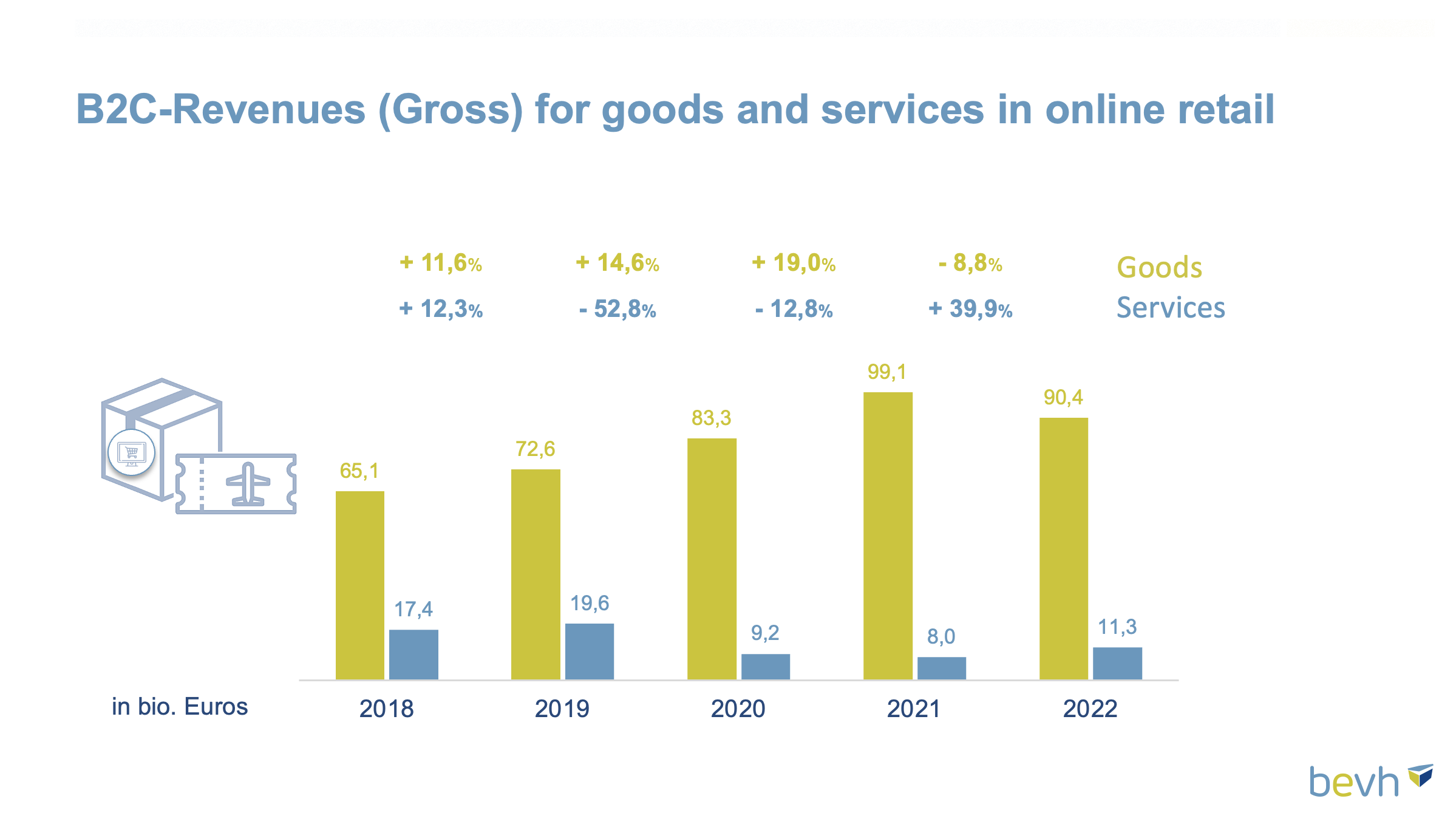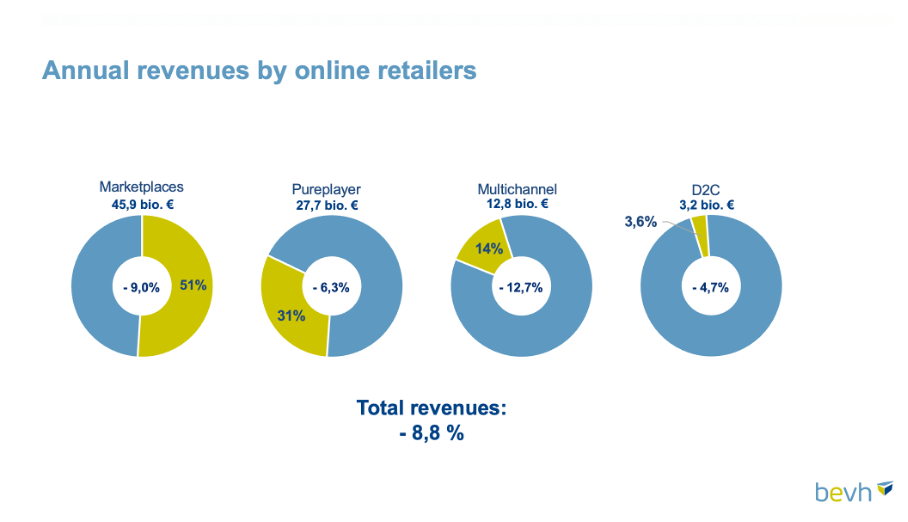Biggest Market in DACH: German E-Commerce revenues shrink for the first time ever
Written by
Editorial TeamPublished on

The numbers are in: German online retails have been hit by inflation in 2022. However, the long-term growth story still seem intact as consumer data by bevh suggests.
The German e-commerce sector was unable to continue the high sales figures of the previous year in 2022, data from the Association for ecommerce an distance selling (bevh) suggests. Gross sales of goods in e-commerce, not adjusted for inflation, fell by 8.8% to 90.4 billion euros in 2022, compared to 99.1 billion euros in the previous year. At the same time, sales of digital services such as holiday bookings or concert ticket sales increased significantly by 39.9% to 11.25 billion euros, following the lockdowns of the first years of the pandemic (previous year: 8 billion euros). As a result, the overall industry revenue was 101.7 billion euros (2021: 107.1 billion euros).
Compared to pre-Corona sales figures (2019), online sales of goods were still 24.5% higher last year. However, services were still 42.2% behind 2019 figures and far from reaching pre-Corona levels.
The share of e-commerce sales of goods in total retail sales (including food but excluding pharmacy sales) fell to 11.8% in 2022 (2021: 14.3%). If we look at only non-food sales, the market share of e-commerce is also 15.4%, below the roughly 20% achieved in the previous year.

German E-commerce is still in demand
A closer examination shows that the revenue development varies depending on the product group and type of supplier. Product groups that meet an acute, non-deferrable need such as household appliances or toys were able to achieve an absolute growth of up to 100 million euros. However, consumers saved on typical impulse purchases. The range for the entire year is from a revenue increase of 6.4% for pet supplies, followed by +3.5% for medication and +1.3% for food, to a decrease of 16.6% for shoes and -12.8% for clothing and books, including e-books and audiobooks.
In 2022, online commerce started off strong with double-digit growth rates, but suddenly dropped when war broke out in Ukraine. Spontaneous purchases, particularly in fashion, hobbies and leisure, as well as consumer electronics, have decreased. However, revenues from everyday purchases of food, beauty products, or medicine, which have been increasingly migrated to e-commerce during the pandemic, have remained stable. “Those who used e-commerce during lockdowns for daily needs will continue to shop online in the future,” explains Martin Groß-Albenhausen, Deputy Managing Director of the bevh.

Revenues also varied greatly by type of retailer. While all types of retailers were affected by declines, the impact was most noticeable among multi-channel retailers, whose online sales partly shifted back to their own brick-and-mortar stores. Revenues for online pure-players and, in particular, manufacturers (direct marketers) were better than the market, but still declining. They were able to expand their share of e-commerce the most during the two years of the corona pandemic and the crisis year of the war in Ukraine.
Customers remain loyal to digital shopping
“We can see that we are dealing with a special, economic development from the fact that the number of active customers remains unchanged, but they are buying less often and for smaller amounts,” Groß-Albenhausen continues. Approximately 3 out of 4 customers (76 percent), more than ever before, regularly ordered online within a month in 2022. On the other hand, the proportion of high-frequency buyers (shopping more than once within the last 7 days) slightly decreased to 42.5 percent (2021: 43.6 percent). At the same time, customer satisfaction with the ordering process has hardly changed: On average, 96.7 percent of weekly surveyed online customers reported being either “very satisfied” (80.3 percent) or “satisfied” (16.4 percent) with the ordering experience. A year earlier, the overall value of very satisfied and satisfied customers was 96.3 percent.
A look at consumer sentiment supports this confidence: The bevh polls online customers every week on how they expect to order in the near future. The proportion of customers who “want to spend less money online and in mail order” accordingly jumped in the 2nd quarter with the outbreak of war and flattened out to 29.8 percent at the end of the year. Conversely, the proportion of those who “want to spend more money online and in mail order” decreased throughout the year and increased again, as in previous years, in the fourth quarter. At the end of 2022, it is at the level of 2019 and 2020 with 9.1 percent.
So, what is next? The bevh expects that the benefits of digital shopping, such as service, transparency and availability, will contribute to e-commerce growing slightly stronger than the overall market again in 2023 with an expected growth rate of 4,8 percent for goods.
***
If you’re looking for more e-commerce insights, find them at the E-commerce Berlin Expo 2023. E-commerce Berlin Expo is the premier e-commerce event in Germany, attracting over 9,000 visitors and showcasing over 250 exhibitors. It provides businesses with a chance to stay updated on the latest trends and advancements in the e-commerce industry through keynote speeches and panel discussions on various topics. The Expo caters to both newcomers and experienced players in the field, making it an essential event for anyone in e-commerce.
![Marketing in Europe in 2026: What's new and what hasn't changed? [McKinsey Report]](https://ecommercegermany.com/wp-content/uploads/2026/01/windows-w79mIrYKcK4-unsplash-720x480.jpg)

